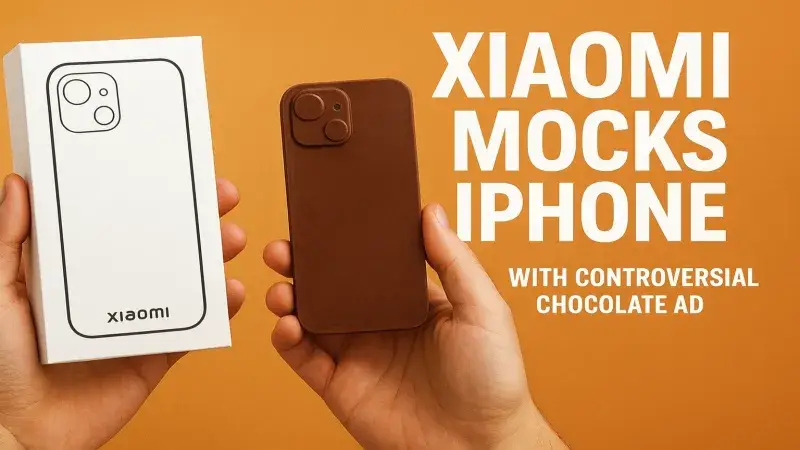Xiaomi mocks iPhone with controversial chocolate ad

In today’s smartphone industry, competition is no longer just about numbers and specs. Smart marketing and creative advertising have become major weapons in the battle for dominance. In an unexpected move, Xiaomi launched a viral ad mocking Apple, using a piece of “chocolate” as a satirical symbol of Apple’s philosophy.
The campaign spread quickly across social media, raising an important question: Can sarcastic ads really influence buying decisions—or are they just attention-grabbing stunts?
The Viral “Chocolate Ad” Explained
The ad, shared on Xiaomi’s official social accounts, featured a sleek box resembling iPhone packaging. But instead of a phone, the box revealed a piece of chocolate shaped like a smartphone.
Xiaomi accompanied it with the tagline:
“Is beautiful packaging enough… or is the real experience what matters most?”
Through this witty jab, Xiaomi highlighted its claim that Apple focuses heavily on branding and design, while not always delivering the same hardware value that companies like Xiaomi provide with feature-packed devices at competitive prices.
Social Media Reactions
The ad went viral within hours, sparking thousands of comments:
-
Xiaomi fans praised the ad as clever and lighthearted, saying Xiaomi managed to shake Apple’s image with nothing but chocolate.
-
Apple loyalists argued it was exaggerated, claiming Apple’s true value lies in its ecosystem and premium experience, not just packaging.
-
Neutral observers saw it as smart marketing that grabs attention—but doubted it would change actual buying behavior.
Apple vs Xiaomi: Clash of Philosophies
Apple’s Philosophy
-
Premium experience centered on seamless integration with iOS.
-
Marketed as a symbol of innovation and exclusivity.
-
Builds long-term loyalty through services like iCloud, Apple Music, and Apple Pay.
Xiaomi’s Philosophy
-
Focused on delivering maximum specs for the lowest possible price.
-
Pushes innovation in camera technology and fast charging.
-
Expands aggressively by appealing to younger, tech-savvy buyers.
Head-to-Head: Xiaomi 14 Ultra vs iPhone 15 Pro Max
Design
-
Xiaomi 14 Ultra: Ceramic or vegan leather back with a sturdy metal frame.
-
iPhone 15 Pro Max: Lightweight, premium titanium design for durability.
Display
-
Xiaomi 14 Ultra: 6.73-inch AMOLED, QHD+, 120Hz, 3000 nits brightness.
-
iPhone 15 Pro Max: 6.7-inch Super Retina XDR OLED, FHD+, 120Hz, 2000 nits brightness.
Cameras
-
Xiaomi 14 Ultra: Quad Leica cameras (50MP x4) with variable aperture.
-
iPhone 15 Pro Max: 48MP main + exclusive 5x telephoto zoom.
Performance
-
Xiaomi 14 Ultra: Snapdragon 8 Gen 3 with advanced AI optimization.
-
iPhone 15 Pro Max: A17 Pro chip (3nm) with console-level gaming performance.
Battery & Charging
-
Xiaomi 14 Ultra: 5300mAh, 90W wired, 50W wireless charging.
-
iPhone 15 Pro Max: 4441mAh, 27W wired, 15W MagSafe wireless.
Price
-
Xiaomi 14 Ultra: Around $1,200 (varies by region).
-
iPhone 15 Pro Max: Starts at $1,199.
The Power of Sarcastic Advertising
Sarcasm in marketing isn’t new, but it has become a powerful tool in modern brand wars.
Famous Global Examples
-
Samsung vs Apple: Samsung’s ads mocking iPhone buyers waiting in line became legendary.
-
Pepsi vs Coca-Cola: Pepsi ran decades-long satirical campaigns to position itself as the “choice of a younger generation.”
Why It Works
-
Viral Potential – Humor and sarcasm spread fast on social media.
-
Emotional Engagement – It makes audiences laugh or react, creating a stronger brand connection.
-
Indirect Comparison – Forces the competitor into defense mode without mentioning specs.
Risks
-
Can backfire if the audience sees it as petty or exaggerated.
-
If not backed by strong products, it may highlight weakness rather than strength.
How the Chocolate Ad Fits Xiaomi’s Strategy
Xiaomi knows it’s competing against a tech giant like Apple. By using unconventional ads, it:
-
Places itself at the center of global conversations.
-
Reinforces the message that value matters more than packaging.
-
Appeals to younger audiences who enjoy humor and shareable content.
Pros and Cons: Xiaomi 14 Ultra vs iPhone 15 Pro Max
| Category | Xiaomi 14 Ultra | iPhone 15 Pro Max |
|---|---|---|
| Pros | 6.73" QHD+ AMOLED, 3000 nits brightness Leica quad 50MP cameras 5300mAh battery, 90W wired + 50W wireless Better value for specs Customizable Android |
Lightweight titanium design iOS stability with long-term updates 48MP + 5x telephoto camera A17 Pro gaming performance Seamless Apple ecosystem |
| Cons | Heavier due to larger battery Shorter software support than Apple Some features launch in China first Lower resale value |
Smaller 4441mAh battery, slower charging Premium price at higher storage Limited customization Dual SIM support missing in some markets |
Which Phone Is Right for You?
Your choice depends on your personal priorities:
-
Choose Xiaomi 14 Ultra if you:
-
Want longer battery life and super-fast charging.
-
Care about pro-level photography and night shots.
-
Prefer the best specs for the money.
-
Enjoy customizing Android for flexibility.
-
-
Choose iPhone 15 Pro Max if you:
-
Already own Apple products like MacBook, iPad, or Apple Watch.
-
Value years of guaranteed iOS updates.
-
Want a lightweight titanium premium design.
-
Prefer a smooth, no-hassle experience without customization.
-
Conclusion
Xiaomi’s “Chocolate Ad” shows that smartphone battles are no longer about specs alone—they’re also about creative marketing wars.
-
Xiaomi proved it can challenge Apple not only with high-performance phones like the Xiaomi 14 Ultra, but also with bold campaigns that spark global debate.
-
Apple, on the other hand, continues to dominate as the gold standard of premium design and ecosystem integration.
Ultimately, the choice comes down to your priorities as a user:
-
If you want power, speed, and maximum value → go with Xiaomi 14 Ultra.
-
If you want prestige, stability, and seamless integration → stick with iPhone 15 Pro Max.